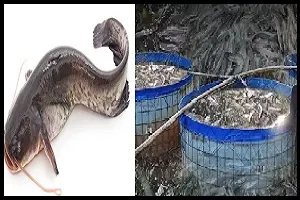Catfish (Clarias sp.) is one of the popular freshwater fish species in Indonesia. Known by various local names in different regions, catfish plays a significant role in the fisheries sector as a cheap, readily available source of food with high nutritional value. Additionally, catfish also holds great potential as a profitable aquaculture commodity for fish farmers.
Characteristics of Catfish
Catfish are characterized by their elongated and smooth bodies, wide mouths with small teeth, and long dorsal and ventral fins. They typically have a dark coloration with a pattern of stripes on their abdomen. Catfish have the ability to thrive in various habitats, ranging from rivers, lakes, swamps, to aquaculture ponds.
Catfish Farming
Catfish farming has become a significant economic activity in Indonesia. The farming process is relatively easy and requires minimal maintenance, making it suitable for both small and large-scale fish farmers. Some steps in catfish farming include:
1. Site Selection
Choosing a suitable location with good water conditions, such as stable pH, ideal temperature, and sufficient oxygen availability.
2. Fingerling Production
Obtaining catfish fingerlings from reputable hatcheries or producing fingerlings independently using healthy broodstock.
3. Rearing
Caring for catfish by providing adequate feed, maintaining water quality, and controlling potential diseases.
4. Harvesting
Conducting periodic harvesting of catfish according to the desired size.
Benefits of Catfish
1. Protein Source
Catfish is a good source of animal protein, low in fat, and rich in omega-3 fatty acids essential for heart and brain health.
2. Affordable Price
Its relatively affordable price makes catfish a popular choice among a wide range of consumers, especially those with economic constraints.
3. Economic Driver
Catfish farming contributes positively to the local economy by creating job opportunities and increasing income for fish farmers.
Challenges in Catfish Farming
Despite its many benefits, catfish farming also faces several challenges, including:
1. Water Quality
Poor water quality can cause stress to the fish and increase the risk of disease.
2. Predator Competition
Catfish are vulnerable to attacks from predators such as carp and eels.
3. Fluctuating Market
Market price fluctuations and demand variations can affect the profitability of catfish farmers.
Catfish Cultivation: A Comprehensive Guide
Catfish (Clarias sp.) farming has emerged as a significant economic activity in Indonesia. Known for its simplicity and profitability, catfish cultivation offers a promising opportunity for both small-scale and large-scale fish farmers. Here is a comprehensive guide to catfish cultivation:
1. Preparation of Pond or Cultivation Vessel
- Choose a suitable location, typically an area with sufficient water flow or easily accessible ponds.
- Ensure that the pond or cultivation vessel has good water quality, with a pH of around 6.5-7.5 and a temperature between 25-32°C.
- Ensure adequate oxygen availability by installing aeration systems if necessary.
2. Selection of Catfish Fingerlings
- Choose healthy catfish fingerlings from reputable sources.
- Ensure that the size of the fingerlings is appropriate for the planned cultivation and the conditions of the prepared pond.
3. Feeding
- Provide high-quality feed suitable for catfish. Commercial pellets are often a good choice.
- Feed the fish regularly, 2-3 times a day, with sufficient amounts to meet their growth needs.
4. Pond Maintenance and Management
- Protect the pond from predators such as birds and reptiles by installing nets or fences.
- Maintain water quality by regularly changing water and monitoring parameters such as pH and temperature.
- Prevent disease by keeping the pond clean and taking preventive measures such as vaccination if necessary.
5. Maintenance and Development
- Monitor fish growth regularly and take corrective actions if necessary, such as adjusting feed or improving pond conditions.
- Observe signs of fish health such as bright coloration, good feeding activity, and the absence of disease symptoms.
6. Harvesting
- Harvest catfish gradually, starting with fish reaching the desired size for harvest.
- Use appropriate equipment and ensure that the harvesting process is carried out carefully to avoid injuring the fish.
By following the steps above and paying attention to environmental conditions and fish health, successful catfish cultivation can be achieved, providing satisfactory results. Good luck!
Conclusion
Catfish is not only an important food source for Indonesian society but also holds great potential as a profitable aquaculture commodity. By adhering to good farming practices and maintaining water quality, it is hoped that catfish production can continue to increase, providing economic, social, and health benefits to communities.
That is the article entitled Easy Way To Raise Catfish For Beginners. If there are any deficiencies or errors in writing this article, Baraja Farm express their deepest apologies. Please leave a wise message in the comments column provided. Thank you for visiting, hopefully it's useful.
Other reading materials, can help with school assignments, click Pustaka Pengetahuan
To increase insight and knowledge, please click Berbagai Reviews
For tutorial on how to cultivate, please click Baraja Farm Channel
Social media please click facebook







0 Komentar